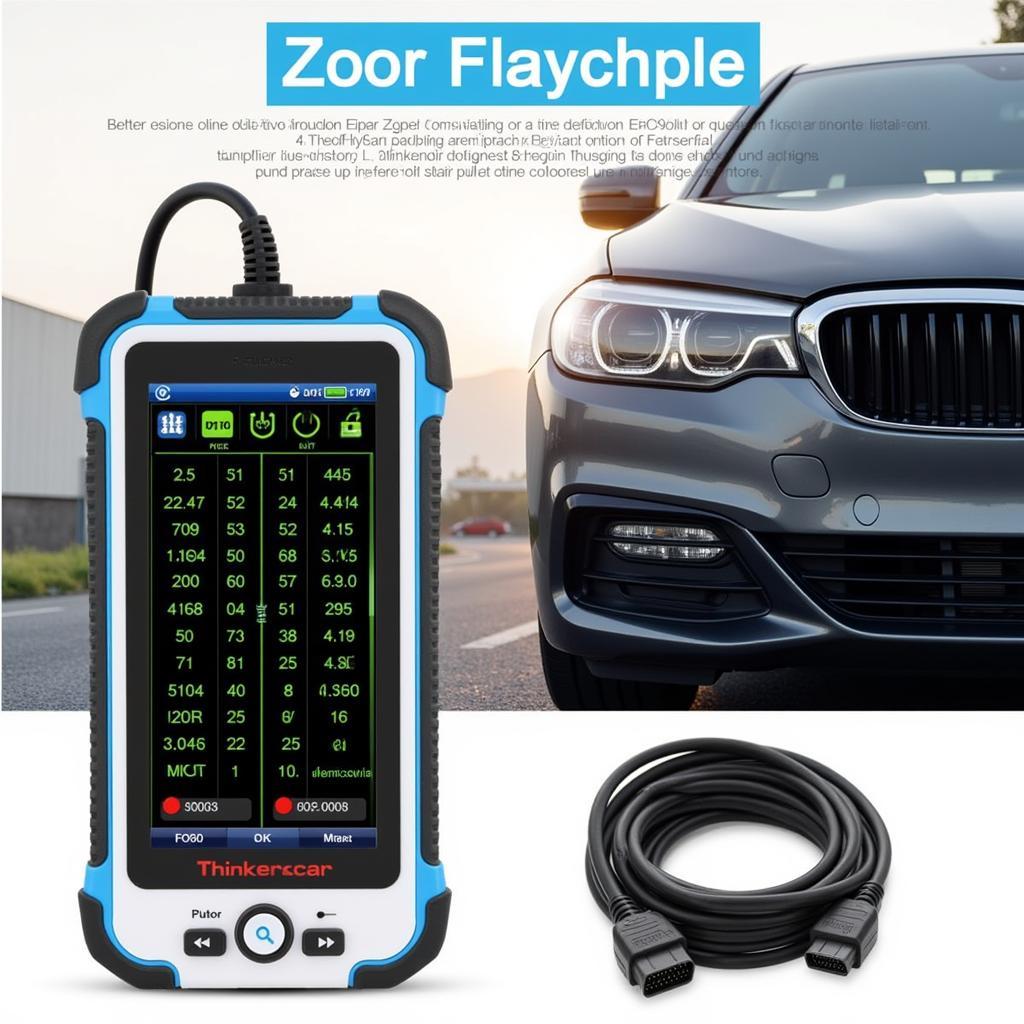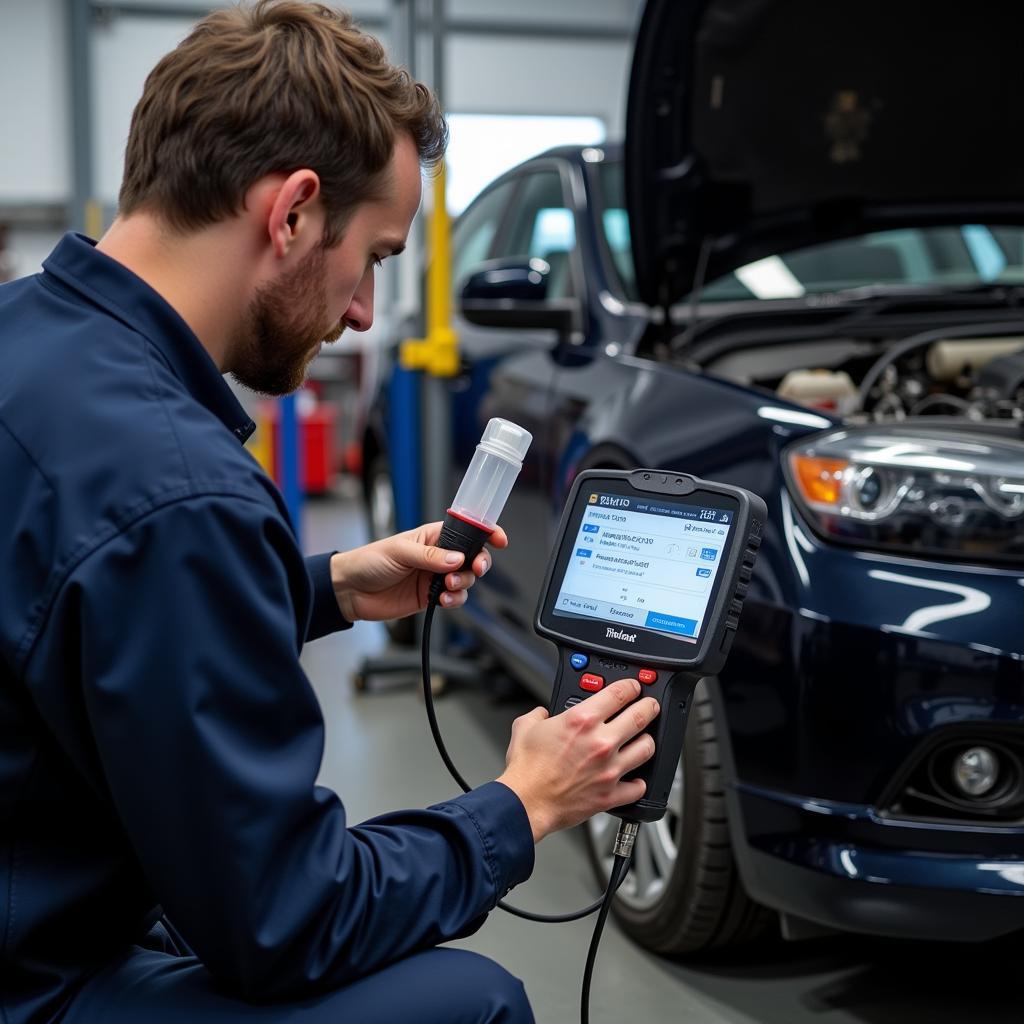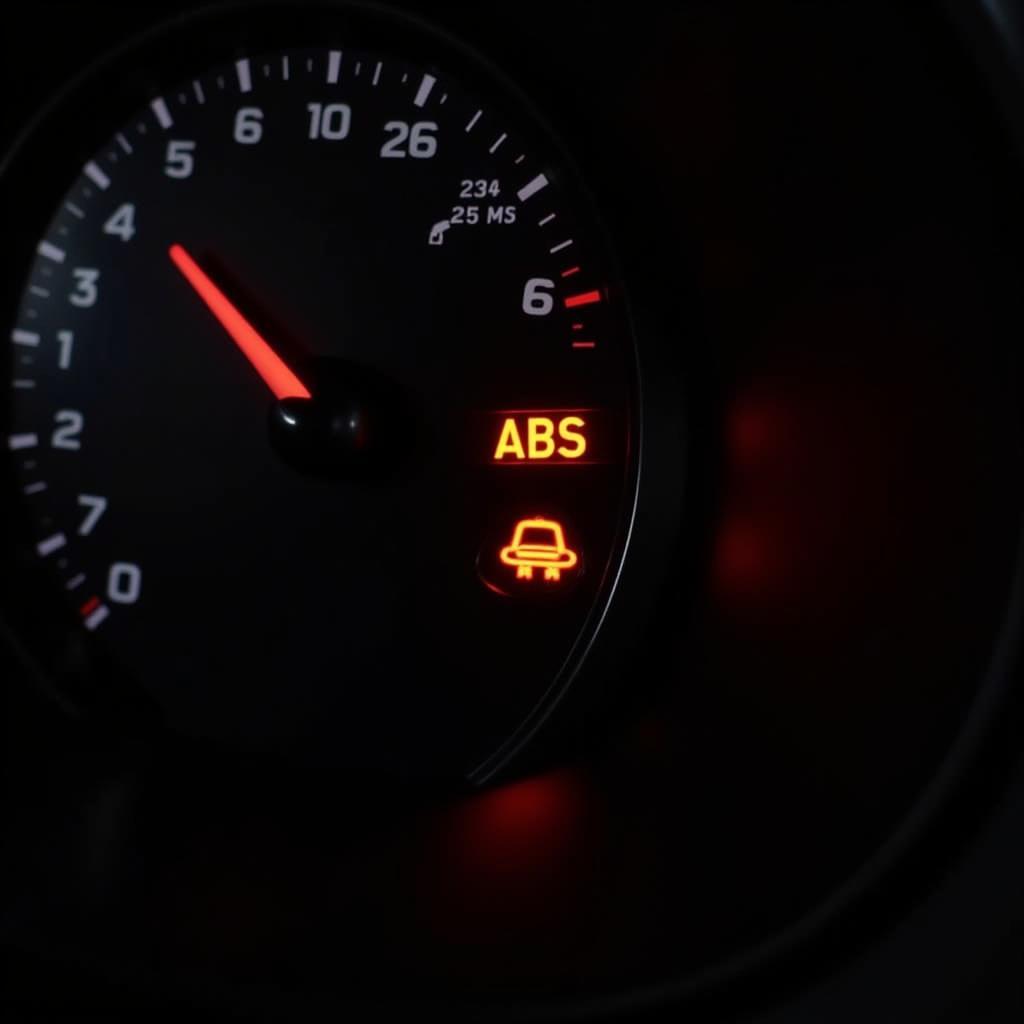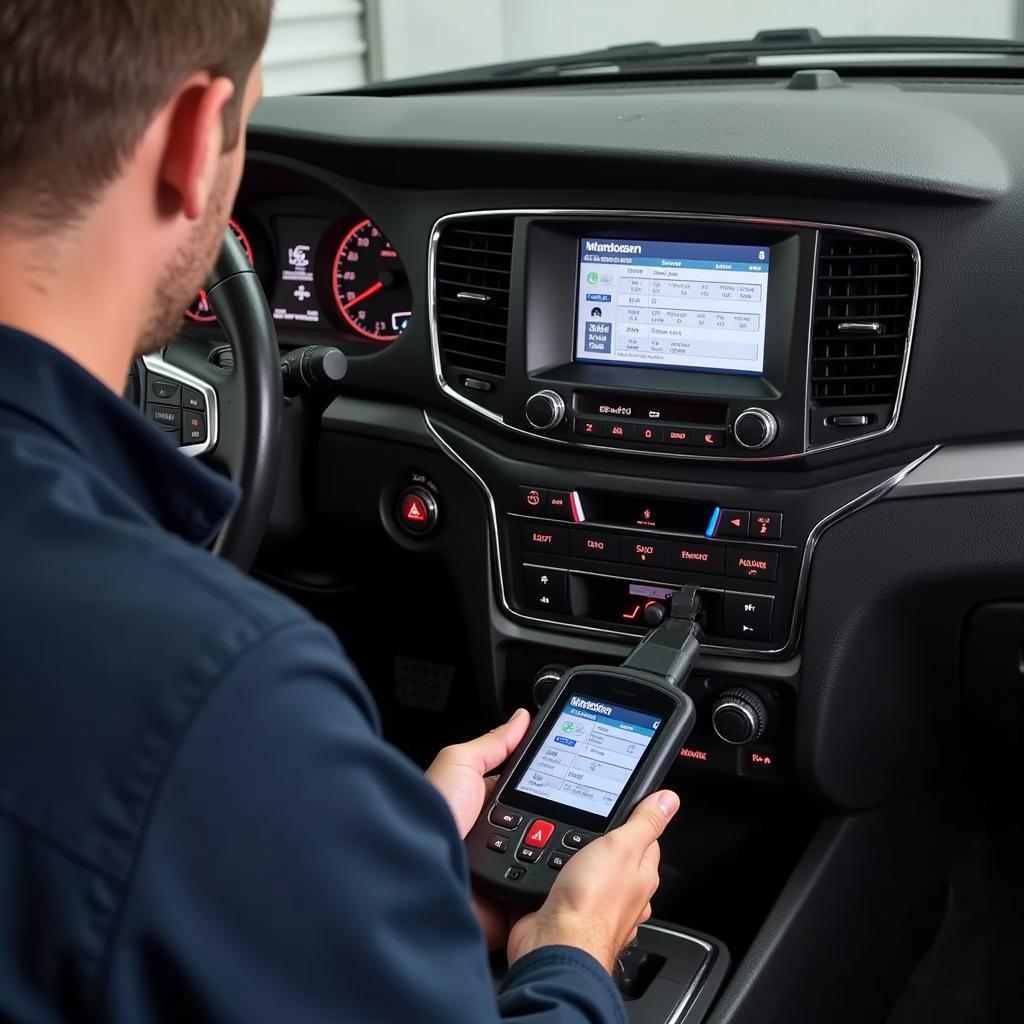The world of automotive diagnostics has evolved dramatically. Gone are the days when mechanics relied solely on their intuition and a handful of basic tools. Today, a Think Diagnostic Scan Tool is an indispensable asset, offering a window into the complex network of a vehicle’s electronic systems. Whether you’re a seasoned mechanic or a car enthusiast looking to delve deeper into DIY repairs, choosing the right scan tool can be daunting. This guide will equip you with the knowledge to make an informed decision and unlock the full potential of these powerful diagnostic tools.
Understanding the Power of a Think Diagnostic Scan Tool
 Think Diagnostic Scan Tool Connected to Car
Think Diagnostic Scan Tool Connected to Car
Modern vehicles are driven by intricate electronic control units (ECUs) that manage everything from engine performance and emissions to safety features and comfort controls. A think diagnostic scan tool acts as a bridge between these complex systems and the user, translating raw data into comprehensible information. These tools empower you to:
- Retrieve Diagnostic Trouble Codes (DTCs): Easily identify the root cause of warning lights on your dashboard by accessing and deciphering the DTCs stored in your vehicle’s ECUs.
- Read and Analyze Live Data Stream: Monitor real-time sensor readings such as engine RPM, coolant temperature, oxygen sensor voltage, and more, allowing for in-depth analysis of your vehicle’s performance.
- Perform Actuator Tests: Activate various components like fuel injectors, solenoids, and relays to verify their functionality and pinpoint potential issues.
- Reset Warning Lights: After addressing the underlying issue, use the scan tool to clear DTCs and reset warning lights, ensuring accurate diagnosis in the future.
- Access Advanced Functions: Depending on the model, some think diagnostic scan tools offer advanced functionalities like ECU coding, key programming, and bi-directional control, allowing for more complex repairs and customizations.
Choosing the Right Think Diagnostic Scan Tool
Navigating the diverse world of think diagnostic scan tools can be overwhelming, but understanding your specific needs can simplify the selection process. Consider these key factors:
1. Vehicle Compatibility: Ensure the scan tool supports the make, model, and year of your vehicle. Some tools specialize in specific manufacturers, while others offer broader coverage.
2. Functionality: Determine the level of diagnostic depth you require. Basic code readers are suitable for retrieving and clearing DTCs, while professional-grade tools offer advanced functionalities like ECU coding and bi-directional control.
3. User Interface: Choose a scan tool with an intuitive and user-friendly interface. Look for features like a clear display, logical menu navigation, and comprehensive help functions.
4. Software Updates: Regular software updates ensure compatibility with the latest vehicle models and diagnostic protocols. Opt for a tool with readily available and easy-to-install updates.
5. Budget: Think diagnostic scan tools range in price from affordable DIY options to high-end professional devices. Establish a budget that aligns with your diagnostic needs and frequency of use.
Maximizing Your Investment: Tips for Effective Use
 Mechanic Using Think Diagnostic Scan Tool
Mechanic Using Think Diagnostic Scan Tool
Owning a powerful think diagnostic scan tool is only half the battle; knowing how to utilize its full potential is crucial. Here are some valuable tips:
- Familiarize Yourself with the Tool: Before diving into complex diagnostics, take the time to understand the tool’s layout, features, and navigation. Consult the user manual and explore the various menus and options.
- Understand the Basics of Automotive Systems: A fundamental understanding of how engines, transmissions, braking systems, and other vital components function will significantly enhance your diagnostic capabilities.
- Start with a Clear Goal: Before connecting the scan tool, identify the specific problem you’re trying to diagnose. Having a clear objective will guide your diagnostic process and prevent aimless data exploration.
- Analyze Data Stream Critically: Don’t solely rely on DTCs. Utilize the live data stream to analyze sensor readings, compare them to manufacturer specifications, and identify inconsistencies that might point to underlying issues.
- Document Your Findings: Keep a detailed record of DTCs, live data readings, and any actions taken during the diagnostic process. This documentation can prove invaluable for future repairs or when seeking assistance from a professional mechanic.
Scan Tool Modes: Unlocking Advanced Diagnostics
For experienced users and professional mechanics, exploring advanced scan tool modes can unlock a deeper level of diagnostic capability. These modes often require specialized knowledge and should be approached with caution. However, they offer valuable insights and control over vehicle systems. Some common advanced modes include:
- Mode $06: On-Board Diagnostic Monitoring Test Results – Provides access to test results for specific monitors within various vehicle systems.
- Mode $08: On-Board Control System Test – Allows for bi-directional control, enabling you to activate specific components for testing purposes.
- Mode $09: Vehicle Information – Retrieves vehicle-specific information like VIN, ECU part numbers, and software versions.
Common Misconceptions about Think Diagnostic Scan Tools
 Car Dashboard Warning Lights
Car Dashboard Warning Lights
Despite their increasing prevalence, some misconceptions surrounding think diagnostic scan tools persist. Let’s debunk some of these myths:
- Myth: Scan tools will magically fix my car.
- Reality: Scan tools are diagnostic tools, not magical repair wands. They provide information to help pinpoint the root cause of a problem, but they don’t inherently fix anything.
- Myth: All scan tools are created equal.
- Reality: As discussed earlier, scan tools vary greatly in their capabilities, functionalities, and price points. Choosing the right tool depends on your specific needs and expertise.
- Myth: Using a scan tool requires extensive technical knowledge.
- Reality: While advanced functionalities might require specialized knowledge, basic code reading and data analysis are relatively user-friendly, even for car enthusiasts with limited technical expertise.
The Future of Automotive Diagnostics
The rapid evolution of automotive technology shows no signs of slowing down. As vehicles become increasingly sophisticated, so too will the diagnostic tools required to service them. Think diagnostic scan tools are at the forefront of this technological advancement, constantly evolving to provide more accurate, comprehensive, and user-friendly diagnostic solutions.
Conclusion
A think diagnostic scan tool is no longer a luxury for professional mechanics but an essential tool for any car owner or enthusiast seeking to understand and maintain their vehicle’s health. By investing in the right tool and continuously expanding your knowledge, you can confidently diagnose and address car problems, saving time, money, and unnecessary trips to the mechanic.
Need help choosing the right think diagnostic scan tool for your needs? Contact ScanToolUS today at +1 (641) 206-8880 or visit our office at 1615 S Laramie Ave, Cicero, IL 60804, USA. Our team of experts is ready to assist you in finding the perfect tool to unlock your inner mechanic.
FAQs
1. Can a think diagnostic scan tool damage my car?
Used correctly, a think diagnostic scan tool is safe for your vehicle. However, it’s crucial to choose a reputable brand and follow the manufacturer’s instructions carefully. Can OBD scanner damage car?
2. What is ECU flashing, and can my scan tool do it?
What does ECU flash programming mean in a scan tool? This refers to reprogramming a vehicle’s ECU with updated software. Some advanced scan tools offer this functionality, but it requires specialized knowledge and should be performed with caution.
3. How do I know if a scan tool is compatible with my Ford vehicle?
You can check the manufacturer’s website or scan tools to reflash Ford for compatibility information. Look for tools that specifically mention support for your vehicle’s make, model, and year.
4. How do I check scan tool compatibility with my car?
How do I check scan tool compatibility? Start by checking the manufacturer’s website or reputable online retailers. Look for tools that explicitly state compatibility with your car’s make, model, and year.

